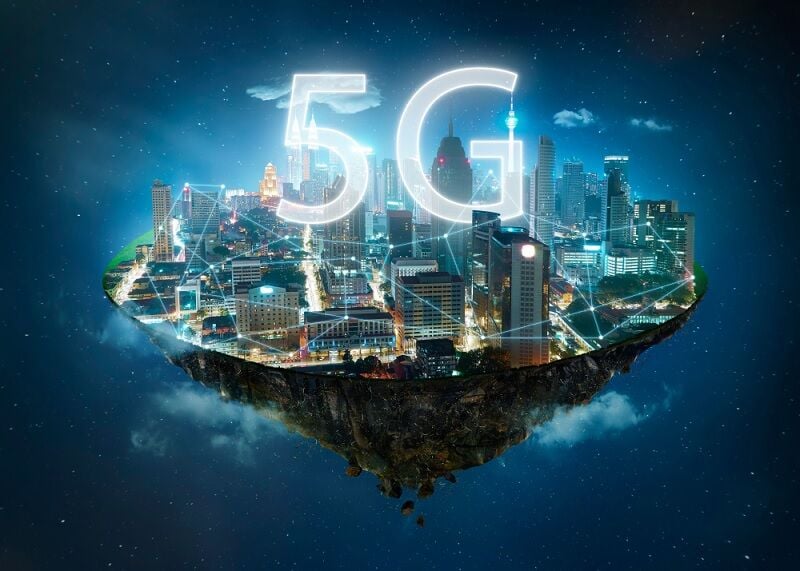Types of 5G technology

As technological advancements continue to expand, explore 5G technology, where data speeds have become incredibly fast. With peak speeds of 20 gigabits per second and average download speeds of 186.3 Mbps in the US and 432 Mbps in South Korea, 5G is changing how you connect, communicate, and use content.
The heart of this revolution lies in the new radio air interface defined by the 3GPP for 5G. With two primary frequency bands, it forms a complex yet fascinating landscape. The FR1 band, also known as sub6, stands out with its maximum channel bandwidth of 100 MHz.
So, buckle up as we discuss the world of 5G technology, exploring its types, capabilities, and the immense potential it holds for the future.
Types of 5G technology

The types of 5G technology have distinctive characteristics and complexity, making them well-suited for different use cases. Let’s delve into the primary classes of Low-band, Mid-band, and High-band 5G, including the Millimeter Wave.
Low-band 5G
Low-band 5G provides a comprehensive coverage area while using frequencies below 6GHz. Designated as Frequency Range 1 (FR1), this swath of the spectrum is crowded but crucial given its long-range capabilities. The maximum channel bandwidth for FR1 is tightly defined at 100MHz, showcasing the precision engineered into 5G’s design.
Mid-band 5G
Mid-band 5G, often associated with frequencies not utilised in preceding generations of mobile communication, offers a compromise between speed and range. These frequencies can reach up to 6GHz. In the world of 5G, balance is key, and mid-band offers just that with its blend of capacity and wide-area coverage.
High-band 5G and Millimeter Wave
Finally, we arrive at High-band 5G and the Millimeter Wave. This is where 5G truly flexes its technological muscle. Falling under the designation Frequency Range 2 (FR2), these frequencies are much higher than those used for Low-band or Mid-band technology, reaching above 24GHz. This high-frequency band creates an opportunity for much faster data rates albeit at the cost of more limited coverage. Consequently, high-band 5G requires a dense network of small cells to overcome its limited range, but the results are data rates that surpass 4G and bring us significantly closer to the theoretical maximum promised by the 5G standard.
Key applications and advantages
Taking forward our exploration of the types of 5G technology, let’s delve into its key applications and the advantages they bring along.
Coverage and accessibility
Starting with low-band 5G, its wide area coverage below 6GHz supports a great number of applications. Public transportation, first responder connectivity, fleet monitoring, and Internet of Things applications deliver fine performances under this type of network. The extended coverage facilitates fixed wireless use, and mobile HD streaming and enhances performance and reliability.
Speed and capacity
Turning the focus towards the high-band 5G or millimetre wave spectrum, it offers data rates up to 20 Gbps. A reflection of this is seen in T-Mobile’s recorded average 5G download speeds of 1863Mbits in the US, with South Korea leading globally at 432 Mbps. More so, 5G networks promise to increase network capacity and efficiency by 100 times compared to 4G networks. This increase in speed and capacity improves applications that typically run in the coverage layer and offers a multi-camera viewing experience, HD visual recognition features, and the possibility of augmented reality.
Technological foundations of 5G

In the realm of 5G technology, there exist several foundational elements that allow it to function at its unparalleled speed and capability. Among them are the New Radio frequencies, Massive MIMO technology, and practices such as Beamforming and Small cell deployment. Let’s unwrap these components.
New radio frequencies
5G greatly expands on the traditional scope of mobile communication frequencies. By definition from the 3GPP, the air interface for 5G, known as New Radio (NR), divides the specification into two frequency bands. The first, Frequency Range 1 (FR1), includes frequencies below 6 GHz. Conversely, the second, Frequency Range 2 (FR2), includes frequencies above 24.5 GHz. This wide breadth of spectral utilisation allows 5G to deliver considerably faster data rates than its predecessor 4G, with recorded peak rates reaching up to 20 gigabits per second (Gbps).
Massive MIMO technology
Your understanding of 5G wouldn’t be complete without exploring Massive Multiple-Input Multiple-Output (MIMO) Systems. These systems contain a large number of small antenna arrays responsible for transmitting and receiving signals. They overcome the limitations of single-input systems, which became inadequate in upholding the growing data needs of an expanding pool of wireless users and interconnected devices. Massive MIMO systems can potentially increase the data rate on a 5G network and also contribute significantly to greater network capacity and improved coverage in comparison to other forms of MIMO technology.
Deployment strategies and challenges
Building upon the technological foundations of 5G, such as New Radio frequencies, Massive MIMO technology, and Beamforming, the deployment strategies and challenges of 5G take the stage. While these technologies offer unprecedented data speeds and network capacity, their practical implementation poses a new set of challenges.
Urban vs rural deployment
When deploying 5G, the density and geographic disparity between urban and rural areas present unique challenges. In urban environments, high capacity and fast data rates are paramount due to the intense demand for wireless data. To ensure this, more Base Stations are deployed, usually positioned on building rooftops or street furniture.
In contrast, rural deployment strategies largely focus on coverage. 5G’s high frequencies, while offering fast data rates, are subject to more signal attenuation and shorter ranges than traditional 4G services. Consequently, dedicated low-frequency bands are sometimes used for rural 5G deployment to maximise signal propagation and achieve an optimal coverage-to-capacity ratio.
Spectrum allocation issues
Another significant challenge in 5G deployment lies in spectrum allocation. Spectrum is a finite resource and its efficient use is a significant concern among telecom operators. There are also regulatory aspects to consider, encompassing both national and international guidelines.
The highest frequency bands like the millimeter-wave (mmWave) spectrum, though holding great potential for speed and capacity, are not without issues. They excel in high-traffic urban areas but suffer from poor propagation and penetrating properties, limiting their suitability for broader, less dense spaces.
Future directions in 5G technology

Riding on the wave of technological advancements, 5G has taken centre stage in the onward march of global connectivity. This section delves into the prospective directions this revolutionary technology might leap towards.
5G-advanced and beyond
There’s a horizon beyond the current 5G technologies, and that’s the realm of 5G-Advanced. This endpoint represents a future strain where the theoretical peak download speed of 20 gigabits per second, originally associated with the International Telecommunication Union’s IMT-2020 standard, becomes old news. The prowess of 5G-Advanced lies in its potential to significantly supersede these speeds. Keep an eye out as this emerging technology continues to unfold, underpinned by rigorous industry standards provided by groups such as 3GPP.
Integration with emerging technologies
5G hardware components echo their 4G LTE counterparts but for three crucial differences: Massive Multiple-Input Multiple-Output (MIMO) systems, Integrated radio, and Edge computing. Integration of these cutting-edge technologies marks a significant step up from existing capabilities.
The role of Massive MIMO systems in this respect deserves a special mention. These systems are power-packed with multiple small antenna arrays, promising an increase in 5G network data rates. Unlike their predecessors — base stations with single-input single-output systems — they aren’t phased by a large number of users and interconnected devices. In other words, they provide high reliability, proving themselves fit for nurturing a promising future of global connectivity.
Your exploration through the intricate realm of 5G technology, from its technological underpinnings to its prospective future has been insightful. You have discerned how New Radio frequencies, Massive MIMO technology, and Beamforming are instigating a revolution in network capacity. Moreover, you have comprehended the intricacies tied to deployment, varying from urban and rural disparities to spectrum allotment and environmental considerations. As we glance at the future, you have had an overview of the potential of 5G-Advanced, characterised by its astounding speeds and the incorporation of avant-garde technologies. It’s indisputable that 5G signifies not just a progression, but a quantum leap in the reconfiguration of global connectivity. As we welcome this novel epoch, the potentialities appear limitless. Therefore, remain updated as the development of 5G technology is merely in its initial stages.
Want to know more about advancements in renewable energy technology? Renewable energy isn’t just a trending buzzword – it’s an essential piece of the puzzle as we strive for a greener tomorrow. Exciting developments in this field are not only shaking up how we think about power but also paving the way for a friendlier relationship with our planet.
Latest Thailand News
Follow The Thaiger on Google News:


























